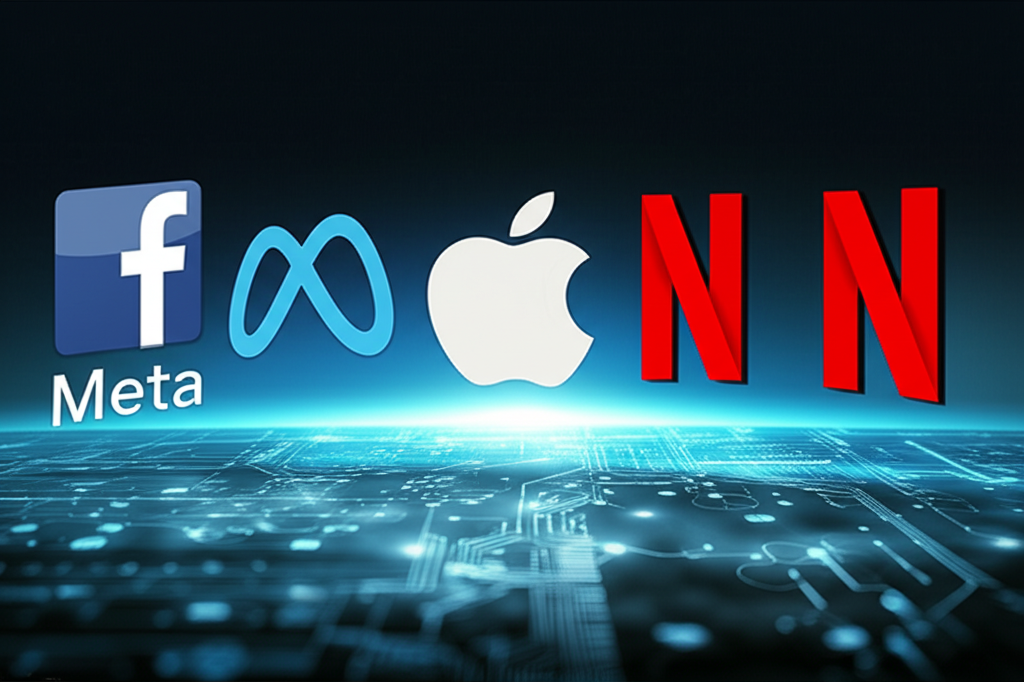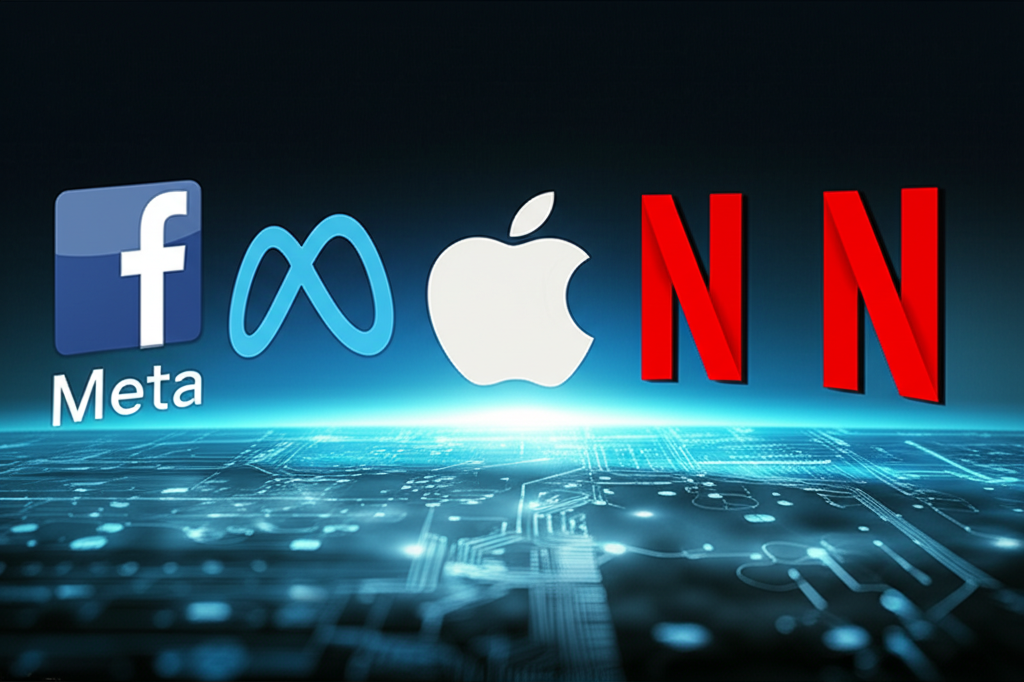Introduction: Decoding the FAANG Acronym and Netflix’s Historic Inclusion

The term FAANG has become more than just a catchy acronym—it’s a cultural shorthand for power, influence, and the vanguard of digital transformation. First popularized by CNBC commentator Jim Cramer in 2013, the label grouped together five American tech titans: Facebook (now Meta), Apple, Amazon, Netflix, and Google (now Alphabet). These companies weren’t just profitable; they were reshaping entire industries, redefining user expectations, and driving global investment trends. Netflix’s presence in this elite circle was particularly noteworthy—not because it manufactured devices or ran social networks, but because it single-handedly upended the entertainment world. Its ability to pivot from a DVD-by-mail service to a global streaming powerhouse marked a seismic shift in media consumption. Yet as the digital economy matures and new players emerge, questions have arisen: does Netflix still belong in this league of technological giants?
What Exactly Constitutes a “FAANG” Company?

Being labeled a FAANG company was never about size alone—it was about impact. The original members shared a DNA of disruption, scalability, and consumer obsession. They dominated their respective markets with near-monopolistic reach, introduced technologies that redefined user experiences, and grew at a pace that defied traditional business models. More than that, they built self-reinforcing ecosystems: Apple with its hardware-software-services triad, Amazon with its e-commerce-cloud-logistics empire, Google through its data-driven advertising and AI infrastructure, Meta via its social connectivity matrix, and Netflix through its on-demand entertainment revolution.
These companies didn’t just respond to market changes—they set them. Their valuations soared not only due to revenue but because investors saw them as long-term disruptors with moats built on data, network effects, and innovation. In this context, FAANG became a proxy for the health of the tech sector, a bellwether for venture capital trends, and a symbol of the new economic order where software and digital platforms could eclipse traditional industrial powerhouses.
Netflix’s Ascent: The Pillars of Its Original FAANG Status

Disrupting Entertainment: The Streaming Revolution
Netflix didn’t just enter the entertainment industry—it rewrote its rules. Before its rise, television was governed by schedules, cable subscriptions, and geographic limitations. Netflix dismantled that model by offering unlimited on-demand access to movies and shows for a flat monthly fee. This wasn’t merely a convenience; it was a cultural reset. Binge-watching became a norm, and viewers gained unprecedented control over what they watched and when.
The company’s global expansion strategy was equally aggressive. By 2016, Netflix was available in over 190 countries, turning a U.S.-centric service into a worldwide phenomenon. But its most audacious move came in 2013 with the release of “House of Cards.” Instead of licensing content, Netflix began producing its own. This vertical integration allowed it to own its intellectual property, reduce dependency on studios, and create exclusive content that drove subscriber growth. The success of originals like “Stranger Things,” “The Crown,” and “Squid Game” proved that a tech company could outperform traditional Hollywood studios in both reach and cultural relevance.
Technological Prowess and Scalability: More Than Just Content
While many saw Netflix as a content company, its real strength lay beneath the surface—in its engineering infrastructure. Long before most enterprises embraced the cloud, Netflix made a bold bet on Amazon Web Services (AWS), migrating its entire streaming platform to the cloud by 2016. This shift enabled unparalleled scalability, allowing the system to handle traffic spikes during peak viewing hours across continents without crashing.
But Netflix didn’t just use cloud technology—it helped shape it. Through its Netflix Open Source Software (Netflix OSS) initiative, the company released critical tools that solved complex problems in distributed computing. Hystrix, for example, improved fault tolerance in microservices architectures by isolating points of failure. Eureka provided service discovery in dynamic cloud environments, while Zuul acted as a gateway for routing and monitoring requests. These tools were adopted by companies far beyond the entertainment sector, influencing how modern cloud-native applications are built. In open-sourcing its innovations, Netflix positioned itself not as a passive consumer of technology but as a contributor to the broader tech ecosystem.
Unprecedented Growth and Market Capitalization (Then and Now)
Netflix’s financial trajectory mirrored its technological ambition. From 2010 to 2020, its market capitalization surged from under $10 billion to over $250 billion at its peak. During this period, it consistently added millions of subscribers each quarter, outpacing even legacy media conglomerates. By 2018, Netflix’s valuation exceeded that of Disney, a company over 90 years old with a vast portfolio of theme parks, studios, and merchandise. This wasn’t just growth—it was a signal that investors believed digital platforms would dominate the future of entertainment.
Even today, despite market volatility and increased competition, Netflix remains one of the most valuable media companies in the world. Its ability to generate consistent cash flow from subscriptions, coupled with its global brand recognition, ensures it stays relevant in any conversation about digital innovation. However, its growth curve has flattened in mature markets, prompting a strategic pivot that brings its FAANG status into question.
The Evolving Landscape: Why Netflix’s FAANG Status is Debated Today

Market Cap Disparity and Heightened Competitive Pressures
One of the most cited reasons for questioning Netflix’s place in the FAANG club is its valuation gap. As of late 2023, Apple’s market cap exceeded $2.7 trillion, Amazon and Microsoft hovered around $1.7 trillion, Alphabet surpassed $1.5 trillion, and Meta approached $1 trillion—all dwarfing Netflix’s valuation, which typically fluctuated between $150 billion and $200 billion. While still substantial, this difference reflects a broader shift in investor priorities. The market now rewards companies with diversified revenue streams, high-margin businesses, and control over foundational technologies like AI, semiconductors, and cloud infrastructure—areas where Netflix has limited exposure.
Meanwhile, the streaming wars have intensified. Disney+ launched in 2019 and rapidly amassed over 160 million subscribers by leveraging its vast IP library—Marvel, Star Wars, Pixar, and classic animation. HBO Max (now Max), Paramount+, Peacock, and Apple TV+ have all entered the fray, often bundling their services with existing ecosystems. Amazon Prime Video benefits from integration with Prime membership, offering free shipping and other perks. This saturation has made customer acquisition more expensive and churn higher, slowing Netflix’s once-steady subscriber growth. In response, Netflix has had to raise prices, cut content budgets, and explore new monetization models—signs of a maturing business rather than a disruptive startup.
Beyond Streaming: Diversification Efforts and Future Growth Vectors
To counter these challenges, Netflix has embarked on a multi-pronged diversification strategy. The most significant shift came in 2022 with the introduction of an ad-supported subscription tier. After years of resisting advertising, Netflix acknowledged that a lower-priced, ad-inclusive plan could attract budget-conscious users and unlock a new revenue stream. Early results showed promise, with ad-tier adoption growing faster than expected and attracting major brands like Unilever and Samsung.
The company has also expanded into mobile gaming, acquiring studios like Night School Studio and launching a curated selection of games included with subscriptions. While still in its infancy, this move positions Netflix to compete in the $200+ billion gaming industry, where engagement and retention are exceptionally high. Additionally, Netflix is experimenting with interactive content—such as “Black Mirror: Bandersnatch”—and live events like comedy specials and wrestling, aiming to increase time spent on platform and differentiate itself from competitors.
These efforts signal a shift from being a pure-play streaming service to becoming a broader entertainment platform. Whether this evolution will be enough to justify its inclusion in elite tech groupings remains to be seen, but it demonstrates a willingness to adapt in a rapidly changing landscape.
FAANG Alternatives: Why Other Tech Giants Aren’t Always Included
The FAANG acronym, while iconic, was always a product of its time. It captured a specific moment in the early 2010s when consumer internet platforms were experiencing explosive growth and reshaping daily life. This narrow focus excluded other tech powerhouses that didn’t fit the “disruptive consumer app” mold—despite their massive influence.
Microsoft, for instance, was long seen as a legacy player, rooted in desktop operating systems and enterprise software. Even as it transformed under Satya Nadella into a cloud and AI leader with Azure and GitHub, it wasn’t part of the original FAANG narrative. Similarly, Nvidia, though foundational to modern computing with its GPUs powering AI training and data centers, operates largely behind the scenes. Its customers are developers, data scientists, and server farms—not everyday consumers scrolling through apps. Tesla revolutionized electric vehicles and autonomous driving, but it’s fundamentally a hardware and manufacturing company, not a digital platform. Salesforce dominates CRM software, but its impact is primarily within business operations rather than consumer culture.
These companies, while critical to the tech ecosystem, didn’t align with the FAANG archetype of a consumer-facing, app-driven disruptor. Their exclusion wasn’t a reflection of their value—but of the specific lens through which the acronym was created.
The Rise of MAANG, MANGA, and Beyond: New Acronyms Reflecting Market Shifts
As the tech world evolved, so did the need for new labels. The emergence of MAANG—replacing Facebook with Microsoft—reflects a recognition of Microsoft’s resurgence in cloud computing, enterprise services, and AI integration. Under Nadella, Microsoft Azure became a major competitor to AWS, and its acquisition of LinkedIn and GitHub expanded its footprint in professional networks and developer tools. This shift acknowledges that long-term dominance isn’t just about user attention—it’s about infrastructure, platform control, and B2B influence.
Another variation, MANGA (Microsoft, Apple, Nvidia, Google, Amazon), swaps Netflix for Nvidia. This change highlights the growing importance of hardware and AI chips in the digital economy. Nvidia’s GPUs are essential for training large language models, running data centers, and enabling advancements in robotics and autonomous systems. With its market cap soaring past $1 trillion in 2023, Nvidia’s inclusion in such acronyms signals a broader redefinition of what constitutes a “core” tech company. As Bloomberg noted, the era of the “Magnificent Seven” (Apple, Microsoft, Amazon, Alphabet, Nvidia, Meta, and Tesla) has replaced FAANG as the new benchmark for market leadership, reflecting a more diversified view of technological influence.
Conclusion: Netflix’s Enduring Legacy and Future in the Tech Landscape
Netflix’s role in the FAANG narrative was never accidental. It earned its place through audacious innovation, technological foresight, and a deep understanding of consumer behavior. Its transition from DVD rentals to global streaming pioneer redefined entertainment, while its contributions to cloud architecture and open-source software cemented its identity as a true technology company—not just a media brand. The fact that it once outvalued Disney is a testament to the transformative power it wielded.
Today, the debate over its FAANG status reflects not a decline in relevance, but a shift in the criteria for leadership. In an era where AI, semiconductors, and enterprise platforms dominate investor attention, Netflix faces the challenge of proving it can evolve beyond subscription streaming. Its forays into advertising, gaming, and interactive content are steps in that direction. Whether it remains in the next generation of tech acronyms may matter less than its ability to continue shaping how people consume stories, connect with content, and spend their digital time.
Netflix’s legacy is secure. It proved that a tech company could disrupt Hollywood, scale globally, and build world-class infrastructure—all while entertaining hundreds of millions. As long as it continues to innovate, its influence will endure, regardless of the label attached to it.
Frequently Asked Questions (FAQs)
Why was Netflix initially included in the FAANG acronym?
Netflix was included due to its groundbreaking role in disrupting the entertainment industry with its streaming service, its rapid global subscriber growth, significant market capitalization, and its strong technological infrastructure built on cloud computing.
What are the key differences between FAANG and MAANG?
FAANG typically refers to Facebook (Meta), Apple, Amazon, Netflix, and Google (Alphabet). MAANG is a newer acronym that often replaces Facebook with Microsoft, acknowledging Microsoft’s renewed market dominance and vast cloud and enterprise businesses, while retaining Apple, Amazon, Netflix, and Google.
Why isn’t Microsoft typically considered a FAANG company?
Microsoft was generally excluded from the *original* FAANG acronym because it was considered an “old guard” tech company primarily focused on enterprise software and operating systems, rather than the consumer internet disruption that defined the initial FAANG companies. However, its resurgence under Satya Nadella has led to its inclusion in newer acronyms like MAANG.
Has Nvidia replaced Netflix in discussions about top tech stocks?
In some discussions and newer acronyms like MANGA (Microsoft, Apple, Nvidia, Google, Amazon), Nvidia has replaced Netflix. This reflects Nvidia’s explosive growth and critical role in areas like AI, data centers, and advanced graphics processing, which have become central to the modern tech economy.
What impact does Netflix’s market capitalization have on its FAANG status?
Market capitalization is a significant factor. While Netflix’s market cap saw tremendous growth, it has more recently lagged behind other FAANG members and newer tech giants. This disparity, alongside increased competition, fuels the debate about its continued inclusion in an acronym meant to represent the absolute top-tier tech companies by valuation and influence.
How has Netflix’s business model evolved since the FAANG acronym was coined?
Netflix’s business model has evolved from primarily subscription-based streaming to include diversification efforts. This includes:
- Venturing into mobile gaming.
- Introducing an ad-supported subscription tier.
- Exploring new interactive content formats.
These changes aim to broaden its revenue streams and attract a wider audience amidst intense competition.
What technological innovations did Netflix contribute that justify its “tech giant” status?
Netflix’s tech giant status is justified by:
- Pioneering large-scale cloud adoption (AWS).
- Developing and open-sourcing significant internal tools (Netflix OSS) for distributed systems, e.g., Hystrix and Eureka.
- Building a robust global content delivery network.
- Innovations in data analytics for content recommendation.
Are there specific criteria that define a “FAANG-worthy” company?
Historically, FAANG-worthy companies exhibited:
- Market dominance and disruptive innovation.
- Rapid and sustained growth.
- Significant consumer influence and brand recognition.
- Strong technological foundation and scalability.
- High market capitalization.
What are the main arguments against Netflix’s continued inclusion in FAANG?
The main arguments include:
- Lower market capitalization compared to other FAANG members.
- Heightened competition in the streaming market impacting subscriber growth.
- Perceived slower innovation pace compared to AI or cloud infrastructure leaders.
What is the future outlook for Netflix in the rapidly changing tech industry?
Netflix’s future outlook hinges on its ability to successfully diversify its business, grow its ad-supported tier, expand into gaming, and maintain its original content leadership. Its continued innovation and adaptation will determine its long-term position as a leading tech and entertainment company.

留言